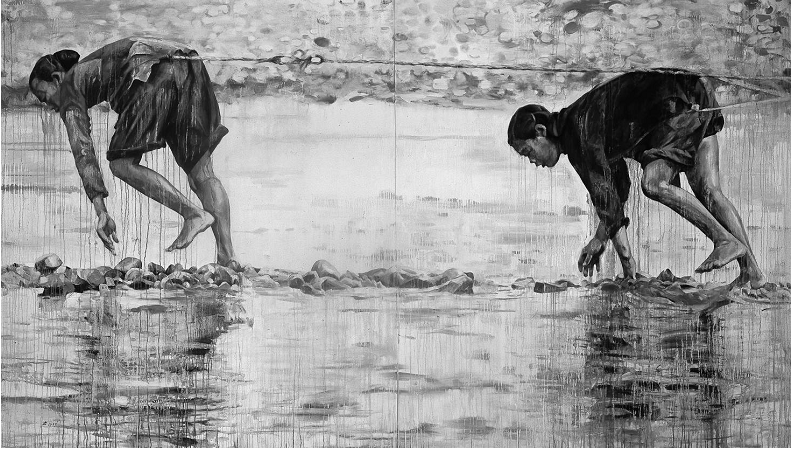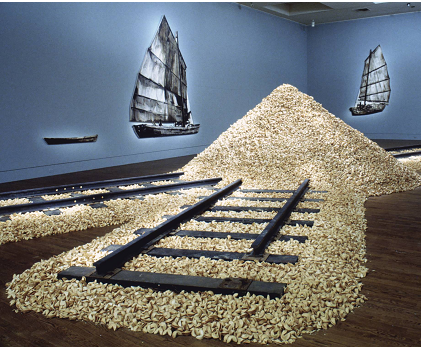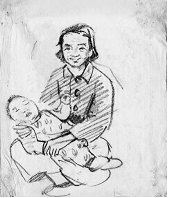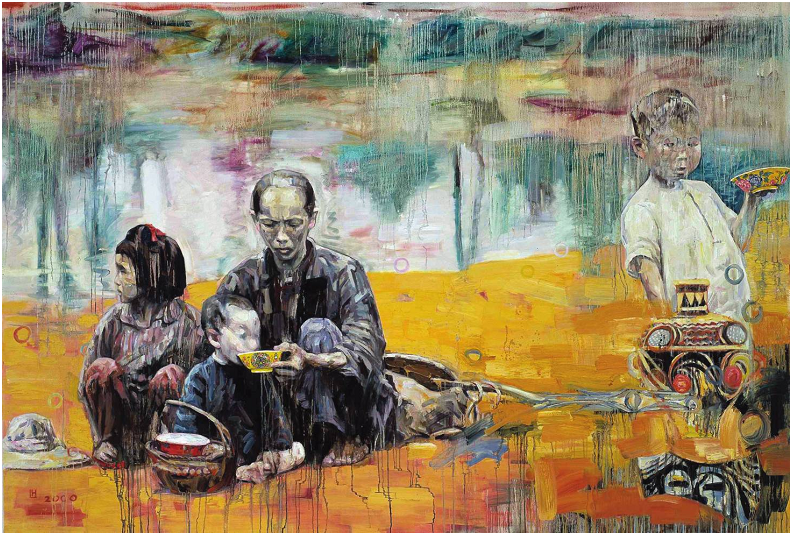Introduction
Born in 1948 in China, Hung Liu is a famous Chinese-American artist who uses her paintings to present themes like gender, culture, politics, and war. Hung acquired her skills in the field of art from the Central Academy of Fine Art in Beijing, where she acquired a Bachelors Degree in Art, and later got a masters degree from the University of California.
Hung uses themes like gender and culture to explain the challenges that women and young girls experience globally. In addition, Hung emphasizes the importance of her themes using paintings, which are very practical in presenting her themes. The fact that Hung is among the early immigrants to the United States gives her a firsthand experience of the gender disparity and racism.
Thus, Hung is very vocal on aspects that focus on women, politics, culture, war, environmental crisis, and struggles of immigrants (Fichner 532). Moreover, the research also conducted through an interview with a colleague (Chiang Lee), who is a Chinese American, concerning his perspective of Hung’s paintings. Therefore, the research paper examines how Chinese-American artist, Hung Liu, addresses themes such as gender, racism, politics, culture, war, and immigrant struggles.
Gender Discrimination
Hung uses her fine works of art to explain the experiences that women and girls go through in their lives. In her famous work titled Goddess of Liberty, Hung employs imagery to demonstrate the effect of gender parity.
Moser explains that the paintings of Hung show women who have been bound on the feet to highlight the challenges that the women encounters globally (80). Hung outlines the theme of gender discrimination from historic periods and stresses her historic presentation by using concubines of emperors to demonstrate that the issue of gender discrimination affects both medieval and modern women and girls.
In her assertion, Hung argues that the emperors’ concubines wore masks to symbolize the authoritarian nature of men, who define the roles of the women. Moreover, Hung adds three cages of birds hanging on her painting to emphasize on the effects of gender discrimination. From a personal interview, Chiang explains that although discrimination against women has reduced compared to historic times, some individuals still perpetuate the vice.

Figure 2: Mother and daughter (Moser 94)
Immigrant Struggles
Another theme that Hung addresses is the immigrant struggles, which explains the dilemmas that Chinese immigrants who came to the United States in the mid-nineteen century experienced. According to Hung, many Chinese immigrants encountered different lifestyles and cultures in the United States. Therefore, most of the Chinese immigrants adopted the foreign cultures and compromised their native cultures.
Some of the paintings used by Hung to explain the vital nature of culture include the portraits of Chinese self, Buddha’s hand, the rainmaker, and the controversial fortune cookie that symbolizes the importance of Chinese culture. The implication of her cultural paintings, which includes the fortune cookie, shows the vitality of culture from Hung’s perspective (Moser 83). Hung uses her artistic skills to encourage appreciation of native culture and lifestyles of Chinese people living in the United States.
In the aspect of immigrant struggles, Chiang explains that since the lifestyles and cultures of people in the United States are different from Chinese lifestyles, many immigrants from China experienced immense challenges in the process of assimilating into the American culture and preserving their culture.

Figure 2: Old Gold Mountains (Moser 92)
Politics
Hung addresses the theme of politics using her homeland of China. From her paintings, Hung demonstrates the importance of good politics and governance.
By using images of Chinese slaves taken captives in Japan after the Second World War and women working on dry fields to recover the lost glory of the Chinese republic, Hung depicts the need for states to exercise good governance and healthy politics. Using numerous wall paintings that are eye-catching and appealing, Hung outlines the past and present political status of China (French 23).
In addition, to enhance the effectiveness of her paintings concerning the present political nature of her home country, China, Hung applies metaphors and figures of speech. Hung uses the figures of speech and metaphors to explain that the political system of China has challenges in terms of political balance. According to the interview, Chiang explained that although China is progressing politically, the country has to institute a number of policies to advance its political system.
Racism
Hung uses most of her paintings to show feelings, operations, and activities that individuals undertake in their daily lives. Since Hung is a Chinese American artist, some of her images depict things that concern her past life in the United States when the vice of racial and gender discrimination was highly pronounced.
Although Hung experienced many instances of racial disparity, however, she used her images to demonstrate the critical nature of living together like brothers and sister irrespective of race. Whenever Hung encountered a situation, she would try to retain it in history using imagery. A good example of artwork that Hung used in addressing the issue of racism focused on the Chinese living in South Carolina.
According to Guzman, Hung’s images are very practical in the study of racial discrimination practiced by some Native Americans during the 19th and 20th centuries (46). From the personal interview, Chiang notes that since Hung was a woman from China who travelled to the United States during the period characterized by high levels of discrimination basing on gender and race, her vulnerability to discrimination was high.

Figure 3: A sketch that demonstrates the need to take care of each other as brothers (Moser 82)
Culture
A number of paintings designed by Hung comprise of fine images that display rich and unique Chinese culture. In her artistic works, Hung displays both the past and the contemporary cultures of Chinese. Remarkably, her artistic works are multicultural, as she incorporates both Chinese and American cultures.
The main motivation of multicultural paintings is her experience in the United States and the need to help young Asian Americans, who experienced cultural dilemmas. Moreover, most of her paintings that focus on Chinese culture are born out of traditional Chinese education, which is the foundation of her present artistic skills (Desmond 23).
The contribution of Hung’s traditional Chinese education is evident from the majority of her images that either have their basis on Chinese photographs from the past or depict Chinese history and culture. The findings from the research also reflect a similar response, as Chiang states that Hung tried very hard to use her painting skills to educate individuals concerning Chinese culture and encourage the Native Chinese to appreciate and love their culture.
War
War is another theme that Hung addresses using her paintings. Most of the paintings that she designed show Chinese slaves captured by Japanese soldiers after the Second World War and the images of Chinese women working on dry plantations to recover the glory of China.
The painting ‘By the Rivers of Babylon’ that shows refugees at the banks of a river running away from war is a good example of how Hung uses imagery to keep historic events alive in the minds of people. Since Hung spent most of her tender age living in China during the period when wars and revolutions were frequent, she uses some of the images to demonstrate the actual state of affairs to many individuals in the United States and globally.
According to the research, it is clear that images of Hung educate many individuals on issues that touch on war and its implications (Ressler 212). Chiang states that through the paintings of Hung, he had acquired a lot of information concerning war, especially in the Asian continent.

Figure 4: By the Rivers of Babylon (Moser 95)
Conclusion
The famous works of art displayed by Chinese-American artist, Hung, are very important and practical in the study of historic events that have shaped human life. The paintings designed by Hung are appealing and attractive since she uses streaks and shadows in enhancing reality of images or photographs. Some of the major themes that Hung addresses include gender discrimination, immigrant struggles, politics, racism, culture, and war.
Additionally, the interview with a colleague (Lee Chiang), who is a Chinese American, highlights the relevance of Hung’s artistic works not only to the past society, but also to the contemporary society. The themes addressed by Hung in her paintings bring to the fore the challenges that human beings encounter in their daily activities. Therefore, Hung’s paintings and images have an enduring influence as they touch on issues of the contemporary world.
Works Cited
Chiang, Lee. Personal Interview. 8 Feb. 2014.
Desmond, Kathleen. Ideas About Art. New York: John Wiley & Sons, 2011. Print.
French, Stephanie. In Plural America. New York: Hudson River Museum, 2012. Print.
Fichner, Lois. Understanding Art. Mason: Cengage Learning, 2011. Print.
Guzman, Rene . Summoning Ghosts: The Art of Hung Liu. California : University of California Press, 2013. Print.
Moser, Joann. “Interview A Conversation with Hung Liu.” Chicago Journals 25. 2 (2011): 76-103. Print.
Ressler, Susan. Women Artists of the American West. McFarland, 2003. Print.